Why Understanding Silver Buy Price Matters
The silver buy price is the actual amount you pay for physical silver, and it's almost always higher than the spot price quoted online. Understanding this difference is key to making smart investment decisions.
Quick Answer: Silver Buy Price Components
- Spot Price: The base market value of raw silver.
- Premium: Added costs for minting, distribution, and dealer profit.
- Product Type: Coins usually have higher premiums than bars.
- Final Buy Price: Spot Price + Premium = What you pay.
Many first-time buyers are surprised by the gap between the spot price and what dealers charge. This gap reflects real-world costs and market dynamics. Silver has been a store of wealth for millennia, valued for its finite supply. In 2024 and 2025, it's in the spotlight as both a key industrial metal for green technology and a safe-haven asset against inflation.
I'm Eric Roach, and after a decade in precious metals and risk management, I've helped hundreds of clients analyze silver buy price trends to build resilient portfolios.
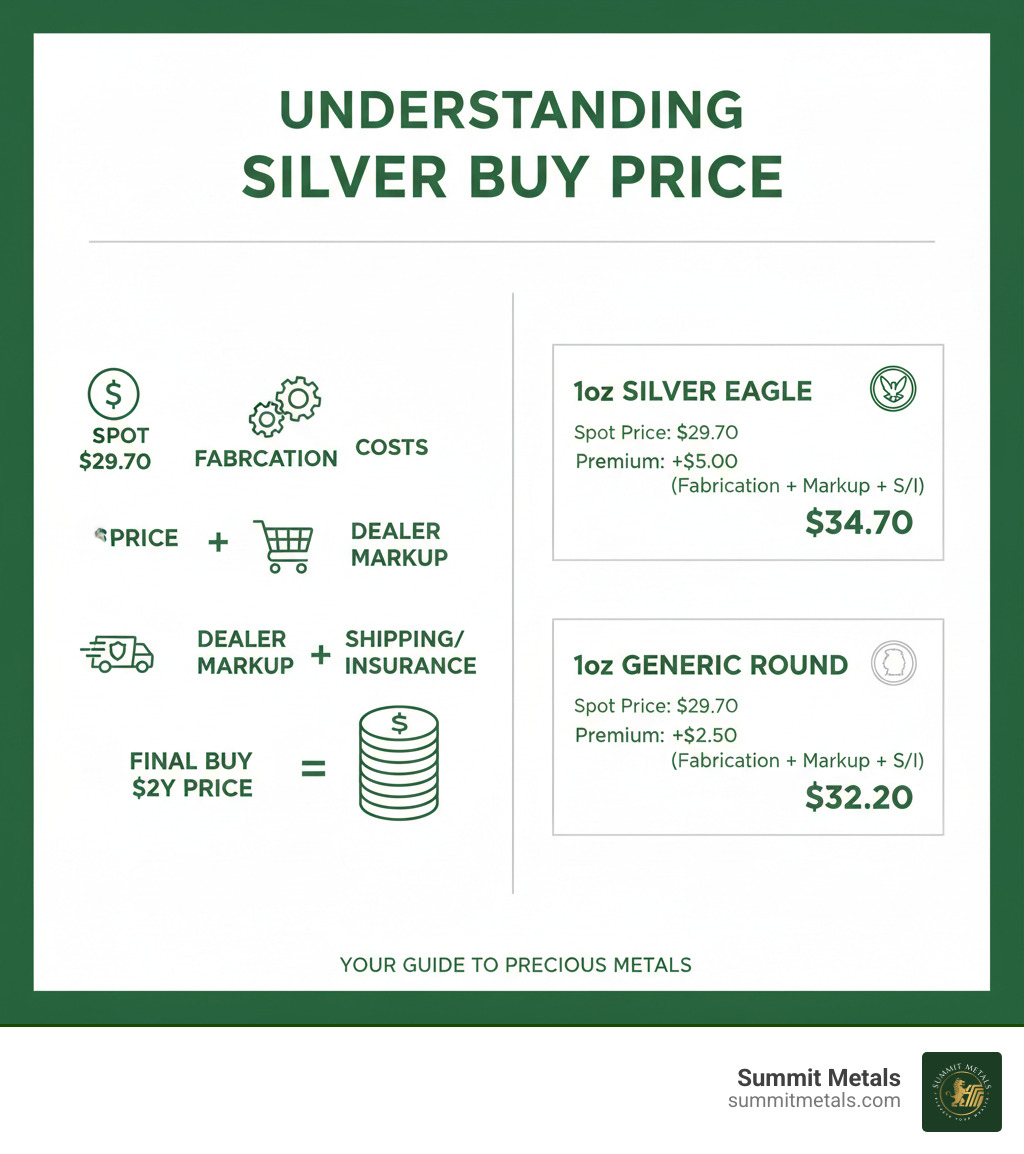
What is the Silver Spot Price and How is it Determined?
Before buying silver, you must understand the spot price—it's the foundation of every silver buy price.
The silver spot price is the live market price for one troy ounce of .999 fine silver for immediate delivery. It's the baseline wholesale price used by large institutions. As a retail investor, everything you pay starts from this number.
The spot price is determined by continuous trading of silver futures contracts on major commodity exchanges, primarily the COMEX in New York. The LBMA (London Bullion Market Association) also provides key benchmark prices, helping standardize the market globally.
A quick note on measurement: precious metals are quoted in the troy ounce (31.1035 grams), which is slightly heavier than a standard ounce.
The spot price fluctuates constantly in response to economic data, currency shifts, and global news. While it's rare, some promotions allow you to snag silver bullion at spot price, but most investors pay a premium.
Spot Price vs. The Price You Pay
You might see a spot price of $29.70/oz but find the retail silver buy price is $32.50. This difference is due to the dealer spread.
Dealers quote two prices:
- Bid Price: The price they pay to buy silver from you.
- Ask Price: The price they charge to sell silver to you.
The gap between these prices is the dealer spread. It covers their business costs, including fabrication, shipping, insurance, and a profit margin. This isn't price gouging; it's the cost of bringing physical metal to the retail market. Competition keeps spreads in check. At Summit Metals, our efficient operations help us keep premiums competitive.
A key rule: if an offer is significantly below spot price, it's likely a counterfeit. No legitimate dealer can sell authentic silver below its intrinsic value.
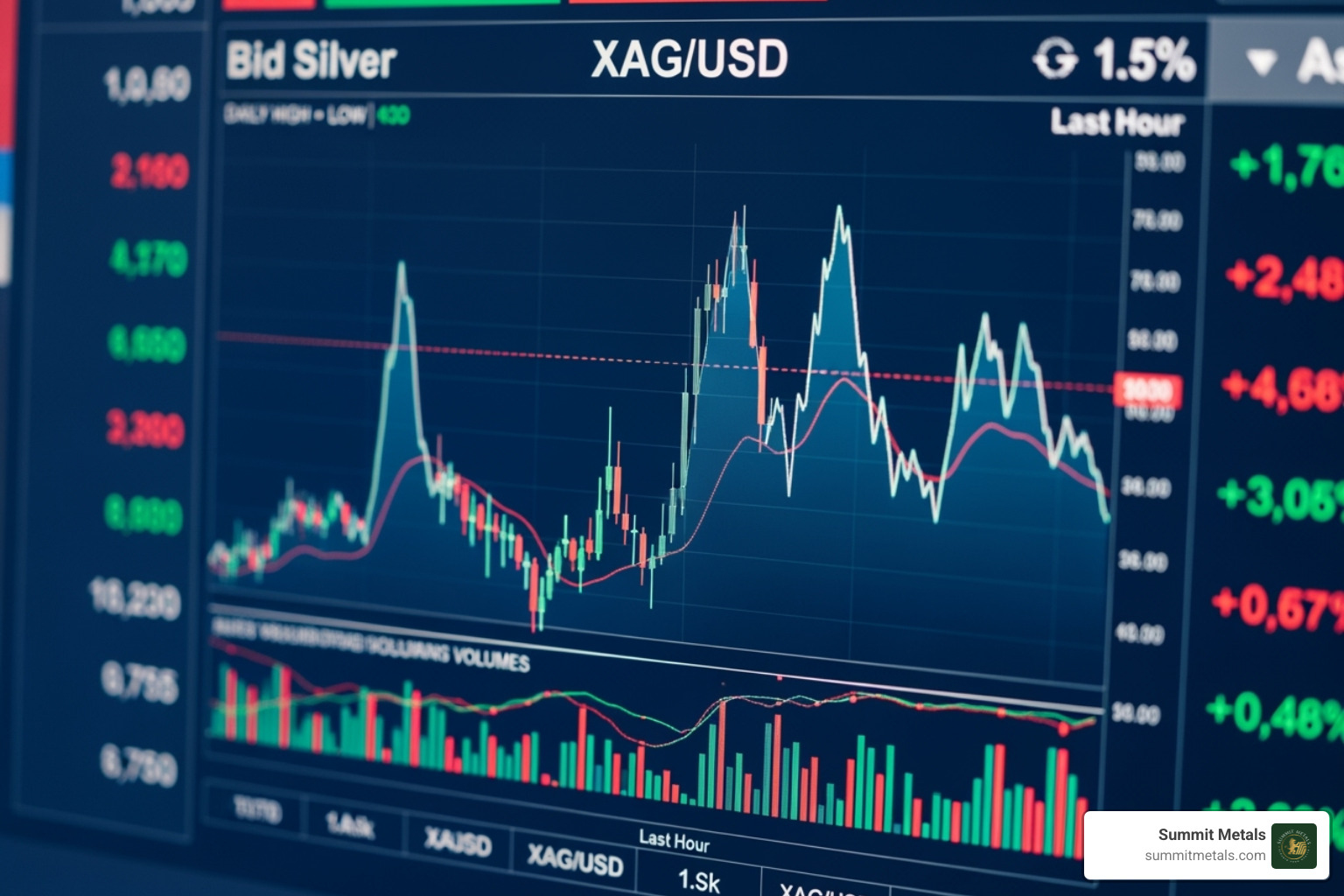
Decoding the Actual Silver Buy Price: Premiums, Purity, and Form
The spot price is just the starting point. The actual silver buy price includes a "premium," which is essential to understand. This premium covers the real costs of turning raw silver into a finished, holdable product.
As we explain in The price of shine: understanding your bullion's premium, these costs include:
- Fabrication: The minting or casting process.
- Distribution: Secure shipping and insurance.
- Dealer Markup: Covers operational costs like security, staff, and verification.
Most investment-grade silver is .999 (99.9%) or .9999 (99.99%) fine, a mark of quality investors seek. Premiums vary widely by product type. A 1-ounce government-backed coin will cost more than a generic round of the same weight due to factors like worldwide recognition and anti-counterfeiting features.
Here’s a quick look at different silver products:
- Silver Bars: Offer the lowest cost per ounce, especially in larger sizes. They are ideal for bulk investment and efficient storage. Explore options in Pure silver bars for sale.
- Silver Coins: Government-minted coins like American Silver Eagles carry higher premiums but offer legal tender status, global recognition, and improved security.
- Silver Rounds: Privately minted and budget-friendly, these are excellent for accumulating weight with low premiums.
- Junk Silver: Pre-1965 U.S. coins (90% silver) valued for their silver content, offering historical appeal and divisibility.
How Form and Purity Impact the Silver Buy Price
The physical form of your silver dramatically impacts its final silver buy price.
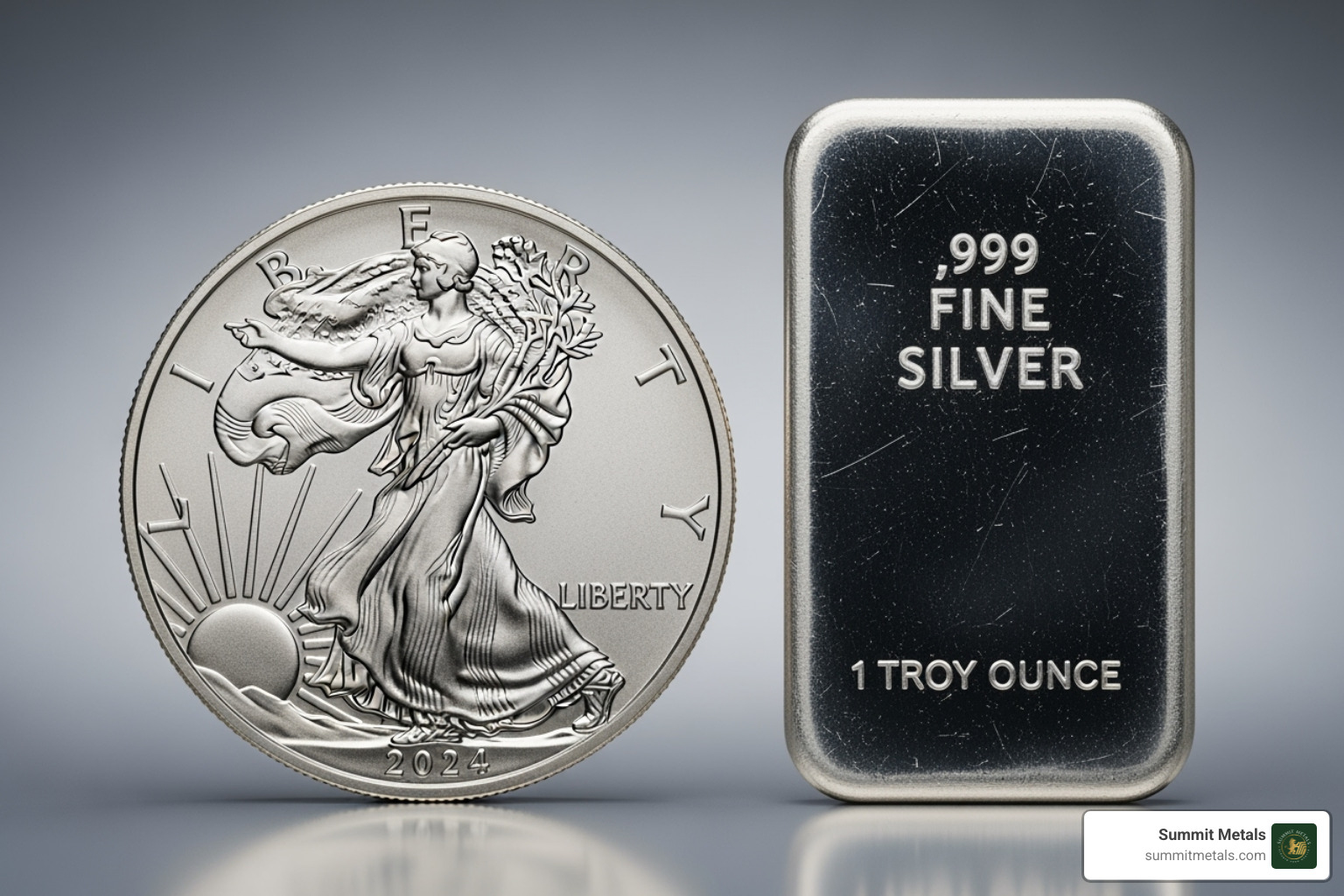
Bullion value (or "melt value") is the worth based purely on silver content. Most investment products trade near this value. However, some coins also have numismatic value as collectibles, which can far exceed their melt value based on rarity, condition, and historical significance. As we discuss in Bars vs. Coins: Unpacking the Differences in Silver Investing, a coin's condition is crucial for numismatic value, while bars typically offer lower premiums.
Comparison Chart: Silver Coins vs. Silver Bars
| Feature | Silver Coins | Silver Bars |
|---|---|---|
| Face Value | Yes (e.g., American Silver Eagle has a $1 face value) | No |
| Government Backing | Yes, for sovereign coins, offering trust and authenticity. | No (typically from private mints). |
| Fraud Protection | Higher, due to intricate designs and government guarantees. | Lower, though reputable brands are secure. |
| Premium Over Spot | Generally higher. | Generally lower. |
| Liquidity | Very high and globally recognized. | High, especially for known brands. |
| Storage | Less efficient for large quantities. | More efficient for bulk storage. |
| Ideal For | Investors seeking recognized assets, fraud protection, and potential numismatic upside. | Investors focused on maximizing silver weight per dollar and efficient storage. |
Understanding the Silver Buy Price for Different Products
Here are real-world examples of how the silver buy price varies (prices reflect the time of publication):
- American Silver Eagles: The benchmark bullion coin, backed by the U.S. government. Learn more in our guide to American Eagle Silver Bullion Coins. A Silver American Eagle sells for $61.19 per coin.
- Canadian Silver Maple Leafs: Known for .9999 purity and advanced security. A Silver Maple Leaf Coin sells for $61.89 per ounce.
- Generic Silver Rounds: The best value for pure accumulation. A 1oz Silver Round sells for $47.40 per ounce.
- Pure Silver Bars: Deliver the lowest premiums, especially in bulk. A 100-ounce bar sells for $6,060.18, which is just $60.60 per ounce.
- Junk Silver: Pre-1965 U.S. 90% silver coins sell for $35.90 per dollar of face value.
Key Factors That Influence the Price of Silver
The silver buy price is shaped by a web of global forces. Understanding these factors helps you anticipate potential price movements.
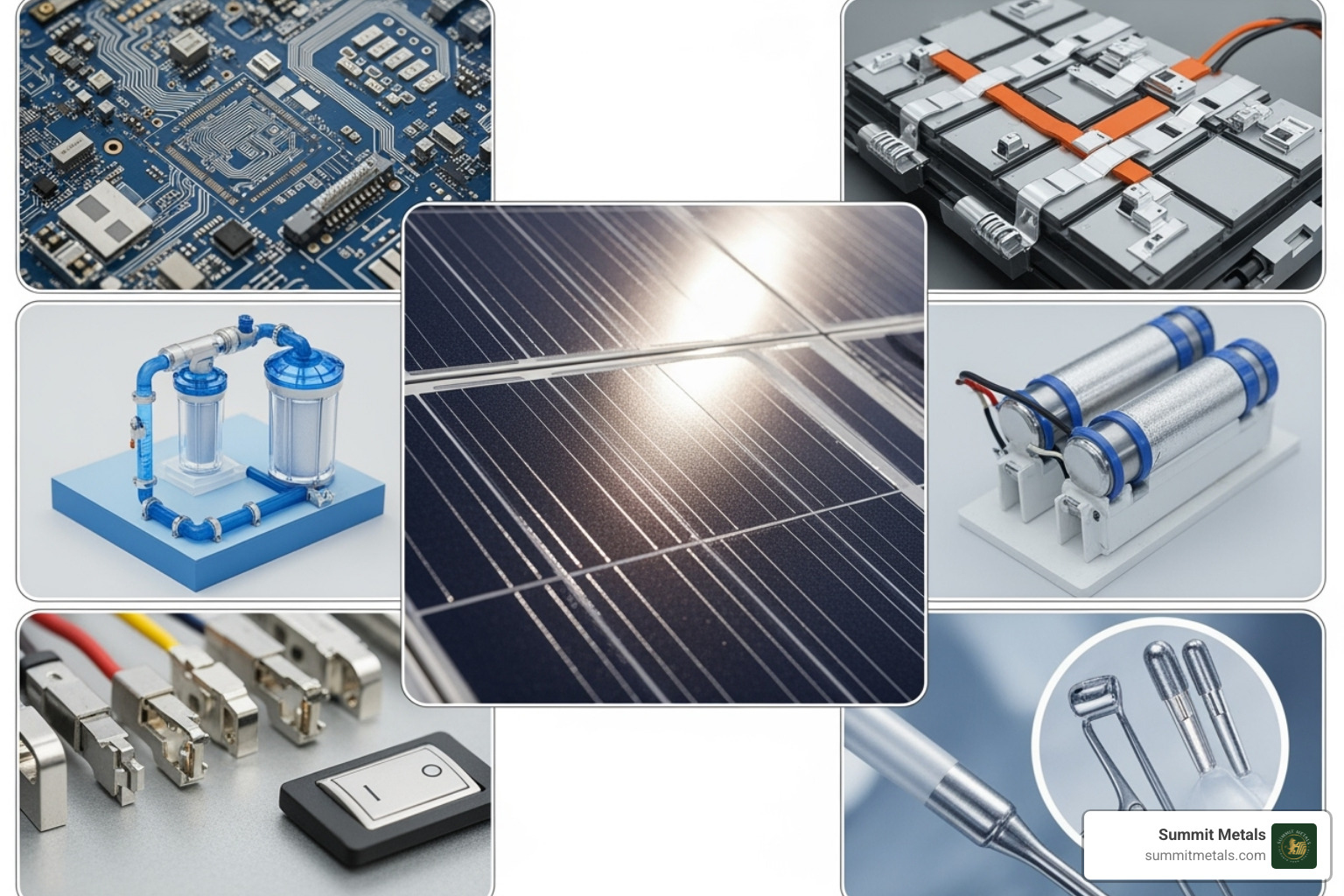
- Investment Demand: During economic uncertainty (inflation, market volatility), investors flock to silver as a safe-haven asset with intrinsic value, driving prices up.
- Economic Indicators: Strong economic data can boost industrial demand. Low interest rates make non-yielding silver more attractive than bonds, while a weaker U.S. dollar typically means higher silver prices.
- Geopolitical Risk: International conflicts and political instability often cause investors to seek tangible assets like silver, increasing its price.
- Industrial Demand: Silver's unique conductive and antibacterial properties make it irreplaceable in technology. The green revolution is a massive driver, with solar panels and electric vehicles requiring huge amounts of silver. This dual role as an industrial and precious metal gives silver unique price dynamics.
- Mining Supply: Production disruptions, such as labor strikes or regulatory challenges, constrain supply and can push prices higher.
You can see how these forces have shaped silver's value over time by viewing the Historical price of silver graph.
The Gold-to-Silver Ratio's Role
A tool sophisticated investors use is the gold-to-silver ratio. As explained in What is the gold to silver ratio? Is it important?, this relative value indicator shows how many ounces of silver it takes to buy one ounce of gold.
A high ratio may suggest silver is undervalued relative to gold, signaling a potential buying opportunity. Investors sometimes rotate from gold to silver when the ratio is high, hoping to increase their total precious metal holdings when the ratio reverts to historical norms. This requires patience and careful market timing. Our Autoinvest program can help by allowing you to set up automatic monthly purchases, letting you dollar-cost average into your chosen metal based on your analysis.
Comparison Chart: Gold Coin vs. Gold Bar
| Feature | Gold Coins | Gold Bars |
|---|---|---|
| Face Value | Yes (e.g., American Gold Eagle has a $50 face value). | No. |
| Government Guarantee | Yes, for sovereign coins, ensuring trust and authenticity. | No (typically from private mints). |
| Fraud Protection | Extremely high due to intricate designs and government backing. | Lower; best to buy from highly reputable sources. |
| Premium Over Spot | Generally higher. | Generally lower. |
| Liquidity | Very high and universally recognized. | High, but may require assay for lesser-known brands. |
| Storage | Less efficient for very large quantities. | More efficient for bulk storage. |
| Ideal For | Investors prioritizing security, recognition, and potential numismatic value. | Investors focused on maximizing gold weight per dollar and efficient bulk storage. |
A Practical Guide to Buying and Selling Silver
Let me walk you through the practical side of building your silver portfolio. Buying and selling intelligently can maximize your returns.
Buying Silver: Authenticity and Reputable Dealers
Your first line of defense is choosing a reputable dealer. If an offer is below spot price, it's almost certainly a counterfeit or a scam.
Buying from established dealers like Summit Metals provides an authenticity guarantee. We provide authenticated metals with clear purity marks (.999 or .9999 fine). For more on this, see our guide on Where to buy certified silver coins.
Online dealers typically offer better prices than local shops due to lower overhead, as explained in our guide to buying silver coins online. Also, note that paying by bank wire or check often secures a discount, as it avoids credit card fees.
Selling Silver: Best Practices to Maximize Your Price
When you decide to sell, you want the best possible price.
- Know Your Product: Understand the weight, purity, and type (bullion vs. numismatic) of what you're selling.
- Check the Spot Price: Know the current market value before you contact a dealer.
- Shop Around: Contact multiple reputable dealers to compare buy-back prices. At Summit Metals, we offer competitive, transparent pricing when you sell to us.
- Negotiate on Bulk: For large quantities, dealers may have more flexibility on pricing.
For most bullion, minor scratches won't significantly affect the price, which is based on melt value. For high-grade numismatic coins, however, condition is paramount.
Smart Buying Strategies: Autoinvest and Bulk Purchases
Two strategies can significantly improve your long-term returns:
Dollar-Cost Averaging: Our Summit Metals Autoinvest program makes this easy. It works like a 401k, letting you set up automatic monthly silver purchases. This strategy mitigates volatility by averaging your purchase price over time, removing the stress of trying to time the market. Learn more about this approach in Silver Linings: Smart Strategies for Investing in Precious Metal.
Buying in Bulk: The more you buy, the lower your premium per ounce. A 100-ounce silver bar has a lower per-ounce premium than one hundred 1-ounce rounds. These volume discounts lower your average silver buy price, maximizing the amount of silver in your stack.
Frequently Asked Questions about Silver Prices
Here are answers to some of the most common questions investors have about the silver buy price.
Why is the price I pay for silver higher than the spot price?
The price you pay includes a premium over the spot price. The spot price is a wholesale benchmark for raw, unfabricated silver. The premium covers the real-world costs of turning that raw metal into a finished product and getting it to you. These costs include fabrication, secure distribution, insurance, and the dealer's operational expenses and profit margin. Without premiums, the physical metals market couldn't exist. You can learn more about the difference between spot price and actual buy price here.
How does the buy price differ for a Silver Eagle coin versus a generic silver bar?
An American Silver Eagle coin will almost always have a higher silver buy price than a generic silver bar of the same weight. The Eagle's higher premium is due to its government backing, which guarantees its weight and purity and provides global recognition. It also has a legal tender face value, intricate anti-counterfeiting features, and collectibility (numismatic value) that a generic bar lacks. Generic bars are produced by private mints and are valued almost purely for their silver content, resulting in lower fabrication costs and premiums. We cover more in our Silver Eagle Silver Dollar Secrets.
How does the condition of a silver coin affect its value?
It depends entirely on the type of coin.
- For bullion coins (like standard Silver Eagles), which are valued for their silver content, minor scratches or dings have little to no impact on their buy-back price.
- For numismatic (collectible) coins, condition is critical. A coin's grade, determined by services like PCGS or NGC, can make its value many times higher than its simple melt value. Even slight wear can dramatically reduce its price.
As we explain in The Value of Perfection: Graded Silver Eagles Explained, a perfect MS70 grade commands a significant premium over a slightly imperfect MS69. For older "junk silver" coins that have been in circulation, condition matters little, and they are valued for their silver content alone.
Conclusion: Making Informed Silver Investment Decisions
You now understand what goes into the silver buy price—from the spot price baseline to the premiums on different products. This knowledge is your advantage.
Silver has a unique dual identity: it's a critical industrial metal for future technologies and a timeless store of wealth that protects against economic uncertainty. When you buy silver, you acquire a tangible asset that exists outside the traditional financial system. This makes it an attractive part of any diversified investment portfolio.
At Summit Metals, our promise is transparent, real-time pricing. Our low overhead and bulk purchasing power mean we pass savings directly to you. We believe in honest pricing on authenticated precious metals.
For a disciplined approach, consider our Autoinvest program. Like a 401k, it lets you set up automatic monthly purchases, using dollar-cost averaging to smooth out your silver buy price over time and build your stack without stress.
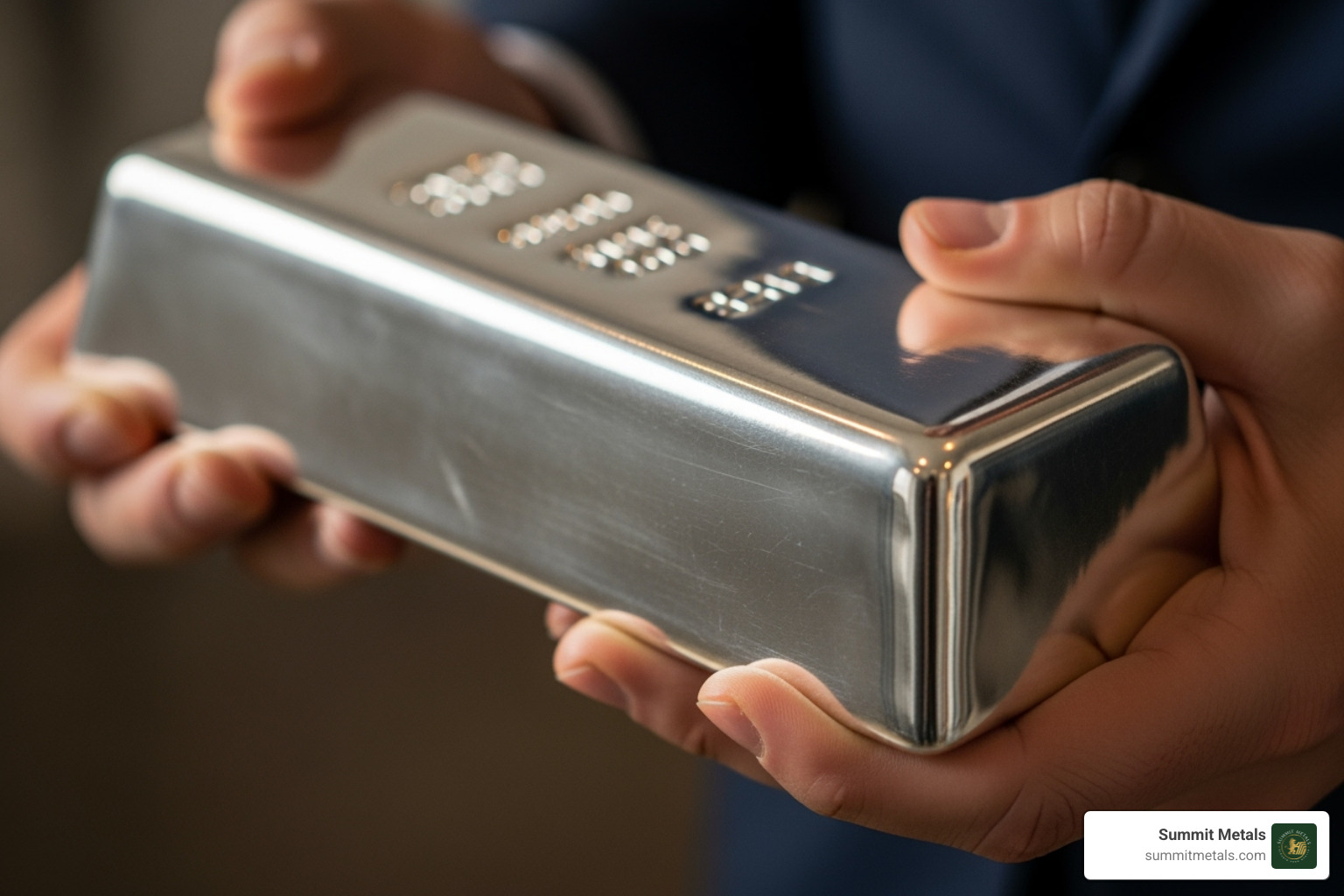
Precious metals are a long-term strategy for wealth preservation. The key is to understand the market, buy consistently, and hold with confidence. The knowledge you've gained here empowers you to make informed decisions that align with your financial goals.
For more strategies, explore Investing in Gold and Silver: A Decision Guide for Savvy Investors. We're here to ensure your experience is transparent, trustworthy, and rewarding.



